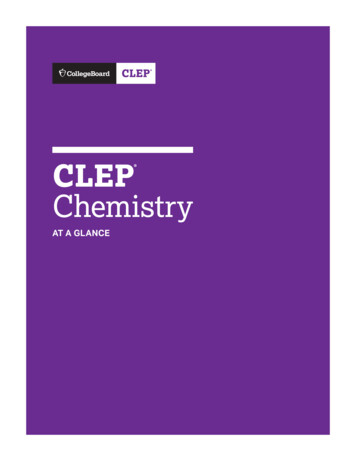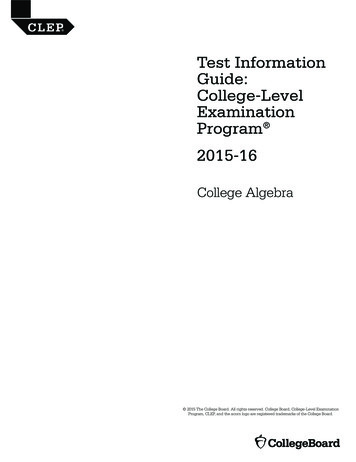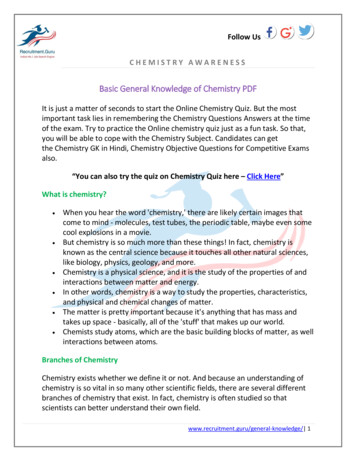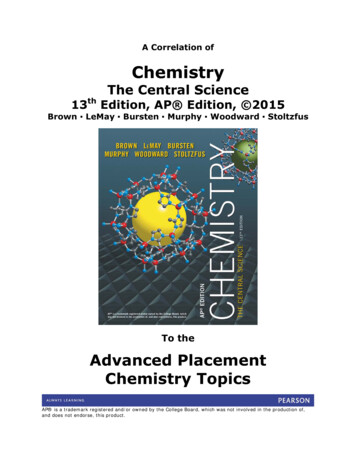
Transcription
CLEPChemistry AT A GLANCE
Description of the ExamThe Chemistry exam covers material that’s usuallytaught in a one-year college course in general chemistry.Understanding of the structure and states of matter,reaction types, equations and stoichiometry, equilibrium,kinetics, thermodynamics, and descriptive and experimentalchemistry is required, as is the ability to interpret and applythis material to new and unfamiliar problems. During thisexam, an online scientific calculator function and a periodictable are available as part of the testing software.The exam contains approximately 75 questions to beanswered in approximately 90 minutes. Some of these arepretest questions that won’t be scored.Knowledge and Skills RequiredQuestions on the Chemistry exam require candidates todemonstrate one or more of the following abilities.§ Recall—remember specific facts; demonstratestraightforward knowledge of information and familiaritywith terminology§ Application—understand concepts and reformulateinformation into other equivalent terms; applyknowledge to unfamiliar and/or practical situations; usemathematics to solve chemistry problems§ Interpretation—infer and deduce from data availableand integrate information to form conclusions;recognize unstated assumptionsThe subject matter of the Chemistry exam is drawn from thefollowing topics. The percentages next to the main topicsindicate the approximate percentage of exam questions onthat topic.20% STRUCTURE OF MATTERAtomic theory and atomic structure§ Evidence for the atomic theory§ Atomic masses; determination by chemical andphysical means§ Atomic number and mass number; isotopes and massspectroscopy§ Electron energy levels: atomic spectra, atomic orbitals2§ Periodic relationships, including, for example, atomic radii,ionization energies, electron affinities, oxidation states§ Nuclear chemistry: nuclear equations, half-lives, andradioactivity; chemical applicationsChemical bonding§ Binding forcesw Types: covalent, ionic, metallic, macromolecular (ornetwork), dispersion, hydrogen bondingw Relationships to structure and to propertiesw Polarity of bonds, electronegativities§ VSEPR theory and Lewis electron-dot diagramsw Hybridization of orbitalsw Geometry of molecules, ions, and coordinationcomplexesw Structural isomerismw Resonancew Sigma and pi bondsw Dipole moments of moleculesw Relation of properties to structure19% STATES OF MATTERGases§ Laws of ideal gases; equations of state for an ideal gas§ The mole concept; Avogadro’s number§ Kinetic-molecular theoryw Interpretation of ideal gas laws on the basis ofthis theoryw Dependence of kinetic energy of molecules ontemperature: Boltzmann distributionw Deviations from ideal gas lawsLiquids and solids§ Liquids and solids from the kinetic-molecular viewpoint§ Phase diagrams of one-component systems§ Changes of state, critical phenomena
Solutions§ Types of solutions and factors affecting solubility§ Methods of expressing concentration§ Colligative properties; for example, Raoult’s law§ Effect of interionic attraction on colligative propertiesand solubility12% REACTION TYPESAcid-base reactions; concepts of Arrhenius, BrønstedLowry, and Lewis; amphoterism4% KINETICSConcept of rate of reaction:§ Order of reaction and rate constant§ Determination of order of reaction and rate constantfrom experimental data§ Effect of temperature change on ratesActivation energy and the role of catalystsThe relationship between the rate-determining step and areaction mechanismReactions involving coordination complexes5% THERMODYNAMICSPrecipitation reactionsState functionsOxidation-reduction reactions§ Oxidation number§ The role of the electron in oxidation-reduction§ Electrochemistry; electrolytic cells, standard halfcell potentials, prediction of the direction of redoxreactions, effect of concentration changes10% EQUATIONS AND STOICHIOMETRYIonic and molecular species present in chemical systems;net-ionic equationsStoichiometry: mass and volume relations with emphasison the mole conceptBalancing of equations, including those for redox reactions7% EQUILIBRIUMConcept of dynamic equilibrium of physical and chemicalchanges; LeChâtelier’s principle; equilibrium constantsQuantitative perspective§ Equilibrium constants for gaseous reactions in terms ofboth molar concentrations and partial pressure (Kc, Kp)§ Equilibrium constants for reactions in solutionsw Constants for acids and bases: pK, pHFirst law:§ Heat of formation§ Heat of reaction, change in enthalpy, Hess’s law§ Heat capacity; heats of vaporization and fusionSecond law:§ Free energy of formation§ Free energy of reaction§ Dependence of change in free energy on enthalpyand entropy changesRelationship of change in free energy to equilibriumconstants and electrode potentials14% DESCRIPTIVE CHEMISTRYThe accumulation of certain specific facts of chemistry isessential to enable students to:§ Comprehend the development of principlesand concepts§ Demonstrate applications of principles§ Relate fact to theory and properties to structure§ Develop an understanding of systematicnomenclature that facilitates communicationw Solubility-product constants and their applicationto precipitation and the dissolution of slightlysoluble compoundsw Constants for complex ionsw Common ion effect; buffers3
The following areas are normally included on the exam:§ Chemical reactivity and products of chemical reactions§ Relationships in the periodic table: horizontal, vertical,and diagonal§ Chemistry of the main groups and transition elements,including typical examples of each§ Organic chemistry, including such topics as functionalgroups and isomerism (may be treated as a separateunit or as exemplary material in other areas, such asbonding)9% EXPERIMENTAL CHEMISTRYSome questions are based on laboratory experimentswidely performed in general chemistry and ask aboutthe equipment used, observations made, calculationsperformed, and interpretation of the results. The questionsare designed to provide a measure of understanding of thebasic tools of chemistry and their applications to simplechemical systems.Study ResourcesMost textbooks used in chemistry courses cover the topicsin the outline above, but the approaches to certain topicsand the emphases given to them may differ. To prepare forthe Chemistry exam, it’s advisable to study one or morecollege textbooks, which can be found in most collegebookstores.A survey conducted by CLEP found that the followingtextbooks are among those used by college faculty whoteach the equivalent course. Most of these have companionwebsites with practice test questions and other studyresources. HINT: When selecting a textbook, check the tableof contents against the preceding Knowledge and SkillsRequired section required for this exam.§ Chang and Overby, General Chemistry: The EssentialConcepts (McGraw-Hill)§ Cracolice and Peters, Introductory Chemistry: An ActiveLearning Approach (Brooks/Cole)§ Gilbert et al., Chemistry: The Science in Context(W.W. Norton)§ Goldberg, Fundamentals of Chemistry (McGraw-Hill)§ Hill, Kolb, and McCreary, Chemistry for Changing Times(Prentice-Hall)4§ Joesten et al., The World of Chemistry: Essentials(Brooks/Cole)§ Kelter et al., Chemistry: A World of Choices(McGraw-Hill)§ Moog and Farrell, Chemistry: A Guided Inquiry (Wiley)§ Snyder, The Extraordinary Chemistry of OrdinaryThings (Wiley)§ Zumdahl and DeCoste, Introductory Chemistry: AFoundation (Brooks/Cole)In addition, the following resources, compiled by the CLEPtest development committee and staff members, may helpyou study for your exam. However, none of these sourcesare designed specifically to provide preparation for a CLEPexam. The College Board has no control over their contentand can’t vouch for accuracy:Free online CLEP Chemistry course:modernstates.org/courseKhan Academy rg State University: General Chemistry .shtmlYou can also find suggestions for exam preparation inChapter IV of the CLEP Official Study Guide. In addition,many college faculty members post their course materialson their schools’ websites.Sample Test QuestionsThe following sample questions don’t appear on an actualCLEP exam. They’re intended to give potential test takersan indication of the format and difficulty level of theexamination and to provide content for practice and review.For more sample questions and information about the test,see the CLEP Official Study Guide.Note: For all questions involving solutions and/or chemicalequations, assume that the system is in pure water and atroom temperature unless otherwise stated.
Questions 1–3 refer to reactions represented by the followingchemical equations.A.B.C.D.E.2 KClO3(s) 2 KCl(s) 3 O2(g)Zn(s) Cu 2 (aq) Zn2 (aq) Cu(s)Co3 (aq) 6 NH3(aq) [Co(NH3)6]3 (aq)H3O (aq) NH3(aq) H2O(l) NH4 (aq)2 C8H18(l) 25 O2(g) 16 CO2(g) 18 H2O(g)1.A Brønsted-Lowry acid-base reaction2.A decomposition reaction3.A combustion reaction4.The attractions between atoms within a molecule ofNH3 are best characterized asA. hydrogen bondsB. ionic bondsC. polar covalent bondsD. London (dispersion) forcesE. ion-dipole forces5.Which of the following is the ground-state electronconfiguration of a halide ion?A. 1s2 2s22p5B. 1s2 2s22p6C. 1s2 2s22p6 3s1D. 1s2 2s22p6 3s2E. 1s2 2s22p6 3s23p16.What is the volume of a 1.5 mol sample of a gas at 35 Cand 2.0 atm?A. 0.053 LB. 0.26 LC. 2.2 LD. 19 LE. 38 L7.8.What is the pH of a solution made by diluting 1.00 mLof 0.10 M HCl with enough distilled water to make 1.00 Lof solution?A. 1.0B. 2.0C. 3.0D. 4.0E. 7.0Credit RecommendationsThe American Council on Education has recommended thatcolleges grant 6 credits for a score of 50, which is equivalentto a course grade of C, on the CLEP Chemistry exam. Eachcollege, however, is responsible for setting its own policy.For candidates with satisfactory scores on the CLEPChemistry exam, colleges may grant credit toward fulfillmentof a distribution requirement, or for a particular course thatmatches the exam in content. Check with your school to findout the score it requires for granting credit, the number ofcredit hours granted, and the course that can be bypassedwith a passing score.Answers to Sample Questions:1-D; 2-A; 3-E; 4-C; 5-B; 6-D; 7-B; 8-D.R(g) 2 T(g) 2 X(g) Z(g)The reaction mixture represented above is atequilibrium at 298 K. The value of the equilibriumconstant for the reaction is 16 at 298 K. If R(g), X(g),and Z(g) each have an equilibrium concentration of2.0 M, what is the equilibrium concentration of T(g)?A.B.C.D.E.0.25 M0.50 M2.0 M4.0 M8.0 M 2019 The College Board. College Board, CLEP, and the acorn logo are registered trademarks of the College Board.Khan Academy is a registered trademark in the United States and other jurisdictions.All other marks are the property of their respective owners. Visit the College Board on the web: collegeboard.org 00951-0795
basic tools of chemistry and their applications to simple chemical systems. Study Resources . Most textbooks used in chemistry courses cover the topics in the outline above, but the approaches to certain topics and the emphases given to them may differ. To prepare for the Chemistry e










